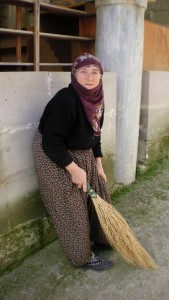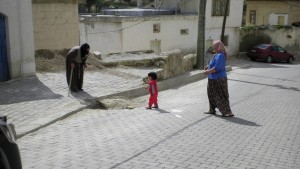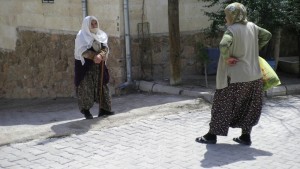I’ve been asking questions since we got to Turkey.
Startlingly often, people have not been able to answer them.
Certainly, some people vamp a bit and try to drum up something that might satisfy; others drop open their yaps and carry on for several minutes before trailing off, looking sheepish at their lack of conclusion; best yet is when the questioned soul simply shrugs and says, “I don’t really know.”
In the case of historical questions, I can admire all of these approaches. When faced with, “So why exactly were all these underground cities constructed, some eight levels deep, complete with chapels, wineries, communal kitchens, and stable areas? Who built them? Were they only used during time of invasion, or were they used other times? How long would people actually stay below ground? Did all of the various cities actually connect by tunnel?”, the questions are unanswerable. Who could know for sure? On one hand, there isn’t enough evidence. On the other hand, there hasn’t been proper research or analysis of the evidence that does exist. On a third, mutant, hand, even with all the evidence and research in the world, the ways and whys of human beings who no longer exist must ultimately boil down to supposition.
Then again, I also sometimes ask questions attempting to determine the departure time of the last bus of the day, and no one can answer those either, even the driver of said bus.
The message from all this has been that, in Turkey, I should yield my urge to make sense of things. That pat phrase of “It is what it is” might be the only key that fits the lock of Once Was Hatti Then Was Phyrgian After Which was Hittite And At Some Point Hosted the Romans Before the Seljuks and Turkmen Stopped By and Warmed the Place Up for the Ottomans Who Laid the Foundation for Ataturk’s Republic Which Is Now Being Counteracted By Regional Fundamentalist Islamization. Patiently, blindly stabbing the key towards the lock often seems the only rational reaction to the complexity of this multi-layered daub of land.
However. One of my trademarks is Unwillingness to Embrace the Rational ™.
Thus, even though I know I’m shouting into an echoing canyon, I persist with the questions.
My hope is that if I trot them out in front of enough faces, eventually I can amalgamate all the half-wrought responses into something larger, something coherent, and, from that, find my peace with the inquiry.
It ain’t for nothing this girl teaches at the community college.
So I ask.
The questions have been wide ranging, cropping up over the last eight months as we’ve negotiated and outfitted a rental, assuaged our children’s pains of transition, gawped at the politics of inbred expatriates, learned that staring isn’t considered rude, accustomed ourselves to male socialization as the basis of culture, relaxed into a host of novel food choices, sat in the dark during repeated power outages, explored white-carved valleys of antiquity. There’s been a lot to take in.
The logistical questions find resolution more easily than do the conceptual ones, naturally. For example, we asked the “foreigner police” what all we needed to do to estabIish residency; they gave us a variety of answers, depending on the day and the guy behind the desk, but eventually we sussed out the requirements and satisfied the whims. But when the questions progress from “What do I need to do?” to a point of “Why do people do such and so?”, I find I am stymied.
Quite specifically, the one question I keep asking of nearly every crowd is:
“So. This head scarf thing? What’s the deal?”
Of course, the question is infinitely more complex than that. A more pointed expression of the question would, in fact, read, “So this head scarf thing? What’s the deal? I mean, here in Cappadocia—admittedly a place that resonates with Arkansas in terms of its forward thinking—how come the majority of women have their heads covered? Having read up on the recent decades of Turkey before setting foot on the plane, I hit Turkish tarmac well schooled in the legacy of the man known as ‘The Founding Father of the Republic,’ the much-revered Kemal Ataturk. Ataturk’s ambitious goal after the devastations of WWI and the ensuing War for Independence was to create a New Turkey, a modern, secular country that shed the trappings of the past–and to that end, Ataturk not only eradicated Arabic and Persian words from the language, but he transformed it from Arabic to Western script and switched the country from the Islamic to the Gregorian calendar; even more, he required the citizens of Turkey to select surnames, gave women the power to vote and hold office, and banned multiple practices, including the constitutional provision for Islam as the national religion, Sheriat (Islamic) law, polygamy, and divorce by renunciation; rounding out his reforms were outlawing of the fez and discouraging the veiling of women. In fact, women holding any public position have not been allowed to cover their heads at all, nor have female students in public schools been allowed to enter the classroom with heads covered. So how come the majority of women I see in any given day have their heads covered…and how come the head coverings take so many different forms? What am I supposed to register when I see each type of scarf? I need a guide to Headscarf Semaphore.”
Although I have been as bewildered as Khloe Kardashian trying to find her lost engagement ring in the dirty laundry, what I know for certain is that Ataturk radically changed his country both from the ground up and the top down. As is the case with radical changes, they were not always accepted with ease. Many traditionalists resented the Europeanization of their country, particularly in the area of religion. While they could go along with Ataturk’s urging ballroom dancing at parties, they struggled with the toning down of their religious culture.
Thus, while many of Ataturk’s reforms were absorbed into Turkish life and viewed as necessary adjustments, many of them have never received total acceptance–and over the years, the resistance to secularization has gained momentum. In recent times, this tension, which had run underground for decades, hit the surface. Not only is there pressure on Turks from other Islamic countries to lead with Islam, there also is the public example of the current Prime Minister, Tayyip Erogan, whose wife and daughters wear headscarves and, consequently, make a public political statement about the correct appearance of modest Muslim women.
It was into this mix of people who never abandoned tradition and people who permanently changed their ways under Ataturk and people who changed their ways for a few generations but are now challenging the reforms of Ataturk by adopting habits that express modern Islamic values in very public fashion that I bumbled and started asking questions.
Is it any wonder the responses have disappointed?
Fortunately, one of the side benefits of an entire year here means that I’ve had time to ask, retreat, regroup, ask again, sit back, watch, meet new people, ask some more, and gradually, imperceptibly,
I’ve started to decipher the signals being sent by the various headcoverings. In turn, I’ve been able to use the headscarf symbol as a means of unlocking the woman beneath, of knowing who she is, based on how and why she covers her scalp. In this fashion, I’ve become fairly adept at reading a woman’s values through the fabric on her head. It was just this superficial indication that Ataturk sought to quash. He wanted to level out his people on the world’s stage and give them a chance to become equal players. Interestingly, the Turkish people, in millions of cases, have resented being dictated to and want to set their own terms of the game.
What this means, in a daily reality, is that more women than not–at least away from the “progressive” West Coast–cover their heads. And here’s what I’ve learned: most of the women in our village, in our neighborhood, wear a traditional “folk” headscarf; at this point in time, it’s made out of polyester and has, around its edges, intricate beading, done by the woman herself. Under the headscarf, the woman’s hair is short, maybe an inch or two long. When such a woman is near her home, she wears only this scarf. But when she leaves her immediate environs and heads out into the world, say, for some shopping, she adds an extra layer of coverage in the form of a long white veil, which trails down her backside. Further, when she will be heading to a public space where she might encounter males outside of her family, she adds a facial covering that juts up from her collar to mask her mouth.
 This is our next-door neighbor (and landlord’s mother), wearing the traditional village scarf.
This is our next-door neighbor (and landlord’s mother), wearing the traditional village scarf.
Below are two of our village neighbor ladies, both in shalwar pants and unassuming headscarves. Note that the older woman, because she’s out on the street, has redraped her scarf to cover the lower part of her face:
When out “in the world,” traditional village woman don the long white veil (over top of the polyester, beaded scarf) as an added measure of protection. Our anthropologist friend tells us this long white scarf dates back to the times of The Virgin Mary. Pass the wine, and let’s get down to the transubstantiation, says I.
Again, these next women wear the traditional village scarf topped by white veil. The further from home they get, the more layers they add:
A last layer is the face mask, which is mostly only worn by older women who are venturing beyond the village square. My hope, always, is that they have blood-red Gwen Stefani lips hidden below the mask:
As I’ve translated scarf into meaning, I’ve realized a few things:
–No matter how I was raised, in a post-feminist era in a relatively-open country, I don’t mind the village headwear; rather, my anthropological bent finds new ways to bend, when it comes to appreciating women who carry on the tradition of their great-great-great-great-great-great grandmothers. Such women stay in the home, raise their children, support each other unquestioningly, and represent a kind of purity not seen in more “advanced” venues. Part of my educated self thinks it should get into a fluff over their lack of opportunities, but a bigger part of me thinks the honesty of their situations merits admiration;
–When introduction moves toward friendship, naturally I have been most drawn to completely uncovered women, those who are often appalled at the politicization of hair. In particular, I adore my friend Ileyn, who, during her explanation of scarves, gestured to a twenty-year-old in a mall, a young woman who proudly wore both the silky fundamentalist political statement headscarf and the underlying “bonnet” before noting, “I could never be friends with her or any woman who does that funky E.T. look on her head”;
–It’s heartening to know I now can identify the covering that riles me: the silky piece of fabric tied under the chin, sometimes wrapped around one side, accompanied by long skirts or trench coats. Although I can judge such women by their exteriors, I don’t know the subtleties of their situations: if they, themselves, chose the covering, or if they were pressured into it by the men in their families. At some point, it’s hard to be too judgmental because I just. don’t. know;
–Possibly the most rewarding part of this whole neck-craning business is the beautiful mash-up of No Simple Answers that has resulted from my line of questioning. It’s like, if Eminem cut a song with Tony Bennett and Weird Al Jankovic and Susan Boyle–you’d be all, “WTF is this? I need to kick back in my recliner with a plate of nachos and riddle out this mind-boggling convergence for a year or two. Bring me my smelling salts, Nigel.” During my observations of Scarf in Action, parts of me have been warmed, parts of me have felt alienated, parts of me have been put off. But here’s the thing:
even with the scarving that states “For one reason or another, I have chosen to project an image of some conservative man’s ideal of Muslim Womanhood,” I am often taken by the face beneath the E.T. skull. Simultaneously, I want to know these women; I want to feel for these women; I want to condemn them; I want to liberate them. It’s all of everything at once.
Do me this solid, though: take a couple of minutes to watch this slideshow of women in conservative headscarves. Are they not beautiful? Are they not glorious? Are they not confident, comfortable, happy to claim their space in the world? Do they not look like they could talk you through tears, make good soup, run a government?
[flickrslideshow acct_name=”70029074@N00″ id=”72157626474382776″]
Ultimately, when I am touched by the warmth that can peep through a covering, I am rueful that the basis of the Muslim scarf is fear–that shielding the female form is ubiquitous because of an essential belief that women must downplay themselves, lest wild men, clearly unable to restrain themselves, attack them. Such logic does an injustice to both kickass women and in-control-of-themselves men. I also continue to question the validity of thinking that asserts “women must save a special part of themselves for their husbands.” To my mind, women can choose how to parcel themselves out. Women who are well matched with their husbands will naturally share the best of themselves. Women should be able to walk down the street naked and suffer little more than a Public Indecency fine. Women should be free to choose other women. Whether in scarves or thongs, women should be the source of their own power.
It would seem, then, that I love women in headscarves at the same time I object to women in headscarves at the same time I see loveliness in headscarves. More power to The Ages, which leave us all equalized in a way Ataturk couldn’t mandate, which render us all skeletons, ashes, mingling with the elements, enriching the earth and depriving the claims of gender and religion.
It’s so simple. So complex.
If it were more straightforward, I’d have to stop asking questions.
And that would be a diminishment I couldn’t accept, so long as there’s an upright, quizzical, uncovered bone in my body.





Leave a Reply to chlost Cancel reply